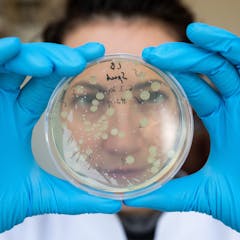
Articles on Genome sequencing
Displaying 1 - 20 of 44 articles

Kākāpō are prone to disease and infertility. Only intensive species management has saved the flightless parrots from extinction. Genome data now reveals the genetic reasons behind these problems.

DNA of the male-determining Y chromosome has been completely sequenced end-to-end, and it’s just as weird as we expected. Will we finally be able to understand how it works?

Time and information is of the essence when tackling infectious diseases across countries and continents.

Why are Australian black swans so quick to die from bird flu? A new genome study comparing them to their bird brethren helps to unravel the mystery.

For the past 13 years I’ve focused on sequencing one plant pathogen’s genome. Here’s where that scientific journey has led.

The first high-quality Australian dingo genome gives a multi-thousand-year-old snapshot into the evolutionary history of dogs.

The African BioGenome Project is a pan-African project that seeks to sequence Africa’s endemic and indigenous plants and animals.

Advances in technology have enabled researchers to sequence the large regions of repetitive DNA that eluded the Human Genome Project.

Improving genomic surveillance to better understand new variants as they arise in different parts of the world could prevent threats to vulnerable health systems and populations.

Without genome sequencing, we would be blind to new variants of COVID-19. As Omicron surges in New Zealand, the sequencing focus is shifting to learning about what causes severe or long-term disease.

The numbat is one of the Tasmanian tiger’s closest surviving relatives. And its newly sequenced genome raises the possibility of piecing together the genetic code of its extinct fellow marsupial.

After a nose swab tests positive for a virus or bacteria, scientists can use the sample’s genetic sequence to figure out where and when the pathogen emerged and how fast it’s changing.

Nuclear bombs use reactions that can occur naturally, but that is a nonsense argument to deregulate them. So why are these same arguments used to promote deregulation of gene technology?

We are being cautious about the implications for vaccine efficacy and transmissibility while we gather more data to understand this lineage.

As more genomes are sequenced, it will become clearer when and how the Delta variant slipped through the New Zealand border. The greater the diversity in genomes, the older and larger the outbreak.

SARS-Cov-2 has experienced roughly the same amount of evolutionary change during the pandemic as humans have since Homo habilis first walked the Earth about 2.5m years ago.

Two decades after the ‘full’ human genetic code was released to global fanfare, researchers have finally filled in the blanks that made up 8% of the sequence, thanks to recent advances in genome sequencing.

Technology that can identify stray bits of genetic material in the environment can help scientists monitor human and animal health.

The highly infectious nature of the COVID-19 variant, and the fact the infections have no clear link to the border, leaves the worrying possibility of a more widespread community outbreak.

How the UK came to be the world leader in sequencing SARS-CoV-2, in the words of a person who made it all happen.
